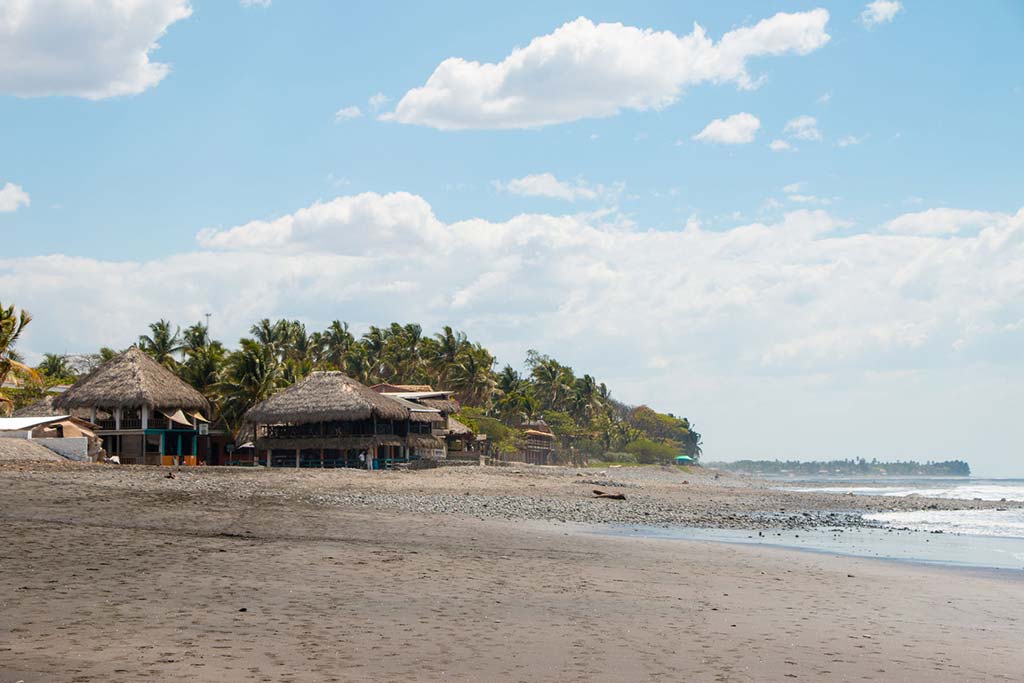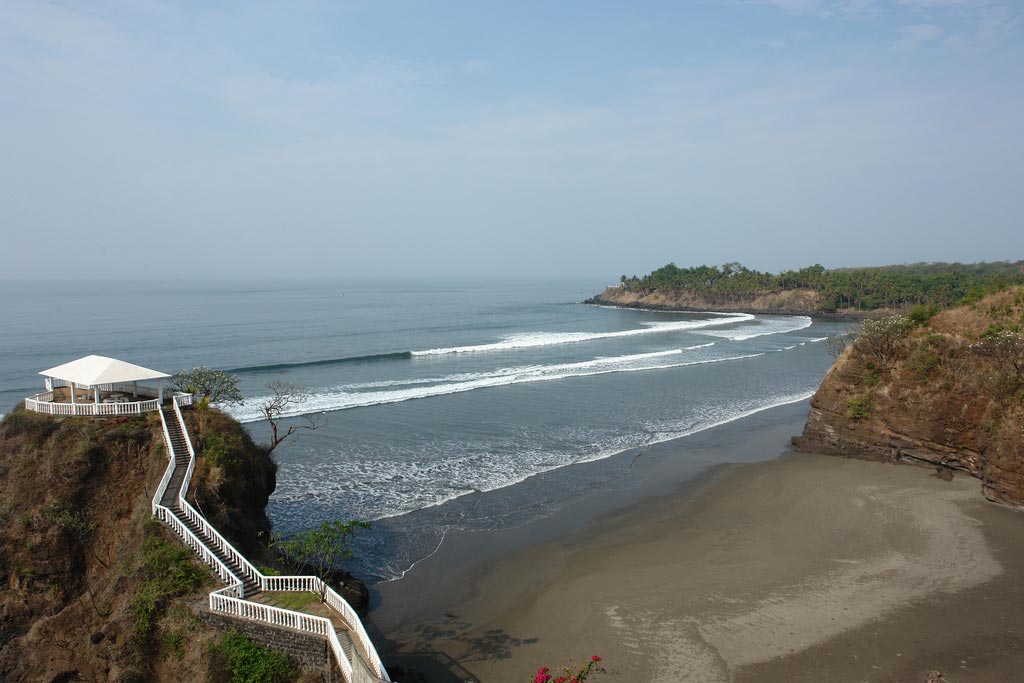The secret is out. For years, the beaches of El Salvador’s coast were strictly the terrain of fearless surfers, some who came in the 1970s and dug the waves so much they never left, even while a civil war raged on. But today, the war is over, the waves are still sweet, and more and more curious travelers are showing up to check out what coastal El Salvador has to offer. They are discovering that the coast is not just for surfers. Yes, there are world-class waves all along the coast line, but these beaches are interspersed with quaint fishing villages and large coral reefs, white sand beaches perfect for relaxing and swimming, mangroves teeming with colorful birds, beautiful bays, volcanic gulfs, and otherworldly estuaries.

Playa El Tunco on El Salvador’s Pacific Coast. Photo © Charles Knoblich/123rf.
Most people head straight for the west coast, a surfer’s paradise that stretches from La Libertad, conveniently located just a 30-minute drive from Aeropuerto Internacional Comalapa, to Mizata, a much remoter western beach. This coastline consists of rocky dark-sand beaches with hot temperatures, strong currents, and rolling, bold waves. The heart of the action is in Playa El Tunco, a popular beach town with a string of beachfront hotels and bars that draw crowds every weekend to enjoy the sun, surf, and sociable evenings. El Tunco has the most variety in accommodations and restaurants, and it boasts the best nightlife outside of San Salvador.
Right next door, Playa El Sunzal doesn’t party. Here you will find great surfing for beginners and experienced surfers alike. Next stop is Playa El Zonte, a magical little beach where the rocky shore and crashing waves are set against the beautiful backdrop of towering cliffs and tropical birds. Keep heading west and you will hit Playa Mizata, a remote getaway with capricious waves that capture the hearts of adventurous surfers searching for solitude. In the small fishing village of Los Cóbanos, simple seafood shacks line the white-sand beach, and the craggy shoreline opens up to the largest coral reef in Central America. Finally, Barra de Santiago boasts the most unique of landscapes due to its location between a mangrove-filled estuary and the roaring Pacific Ocean.
On the other side, the east coast offers expansive white-sand beaches, unexplored islands and bays, and when the conditions are right, some of the best surfing in the country. Heading east from San Salvador, the first and arguably most beautiful beach in the country is Costa del Sol, where a long stretch of pearl gray coast is flanked by the Jaltepeque Estuary, a prime location for fishing and birding, or simply relaxing on the beach with a cocktail in hand. Next up is Isla Montecristo, where untouched beaches, mangroves, and cashew plantations make a perfect destination for those seeking peace and solitude in a rustic setting.
Next, Bahía de Jiquilisco is Central America’s largest remaining mangrove forest and coastal estuary, providing critical habitat for birds and the most endangered turtle species in the world, the beautiful hawksbill. Farther on, Playas El Cuco, Las Flores, and Esterón offer excellent surf and beautiful beaches. If you make it to where the ocean’s shore meets the country’s edge, the islands in the Golfo de Fonseca offer raw natural beauty for intrepid travelers who seek off-the-beaten-path adventure.

Playa Las Flores. Photo © Jorge Lazo, licensed Creative Commons usage.
Two weeks is enough time to enjoy the coast of El Salvador, but realistically most people usually only have about a week. Unless you are doing a targeted surf trip, it is not easy to get both coasts in one week. It’s better to choose one, and most people choose the west, as it is more developed for tourism and easier to get to from the airport or San Salvador.
Traveling the west coast is easy. There are buses that run along the Carretera Litoral (coastal highway) frequently, and you can flag one down at any point. Whether you are surfing or not will influence how much time you want to spend here; in general, a week should be enough time to see all the beaches on this side of the country.
Your time on the east coast also depends on whether you are surfing or not. One or two days in Playa El Cuco and vicinity should be enough, but many people end up staying longer (or wishing they could). Bahía de Jiquilisco and Isla Montecristo take a bit more time to reach, but one day and one night in each place is enough to do a tour, take in the natural beauty, and move on. If you plan to go to the Golfo de Fonseca, you will need two days. There is only one boat that leaves the islands for the mainland each day, very early in the morning, so unless you hire a private boat, you will have to spend the night on Isla Meanguera.
You can learn to surf at any time of year, but November to February offers ideal conditions for beginners. The waves are smaller and there are consistent offshore winds. Peak surfing season is March to October, so expect the more popular surf resorts to be fully booked most of the time.
Excerpted from the first edition of Moon El Salvador.